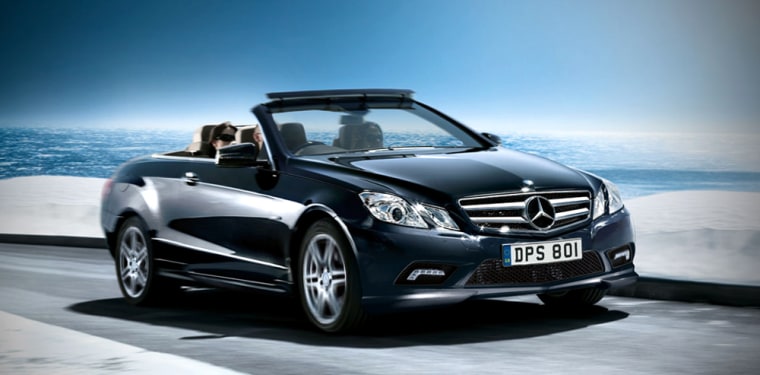For many prospective customers, convertibles conjure images of cold drafts and windblown hair, a stereotype Mercedes hopes to overcome with the introduction of its new E-Class Cabriolet.
The mechanical wizards in Stuttgart have concocted technical cures for these age-old problems, making top-down driving pleasant and fun in temperatures that would normally cause us to reach for the button to raise the roof.
The scrappy underdogs at Mercedes will celebrate the 125th anniversary of the company’s invention of the automobile next year, and their accumulated proficiency is evident in this latest model, which retails for almost $74,000 as tested.
Its neatest tricks are the Aircap and the Airscarf. The Aircap is an active wind spoiler that rises across the top of the windshield at the touch of a button in the center console. Having this wing protrude atop the windshield is admittedly dorky-looking, but it effectively directs air that would otherwise curl and crash like the surf at Waikiki onto the heads of the rear-seat passengers.
At top-down touring speeds, the Aircap renders the back seat as comfortable as the front seat in other cars. It also makes the front seat an island of placidity, even without the windows raised, which is just one step too far on the dorkiness scale for this reviewer.
The good news about the Aircap’s unconventional appearance is that because it is only effective at higher speeds, the driver can retract it before pulling to the curb at the destination. Mercedes could have done better by having an automatic function that would deploy the Aircap at highway speeds and retract it in town, the way the similarly ungainly rear spoiler does on Porsche’s Boxster roadster.
While Aircap is brand-new, the Mercedes faithful have already seen Airscarf on the company’s two-seat convertibles. This marks the technology’s debut in a four-seater. Airscarf is a system of ducted warm air that blows from the seat backs' tops onto the necks of the front seat occupants. The vents are even directionally adjustable to help compensate for the occupants’ height and collar style.
Seat heaters remain the additive crack cocaine of automotive comfort technologies, but Airscarf easily meets the needs of top-down touring aficionados.
If Mercedes’ laboratory magicians can only conjure topless protection from rain and ultraviolet overexposure, the company will have the truly perfect double-date cruiser.
Putting a couple into the rear seat of the E-Class is best done with the top down. If the weather is unsuitable for alfresco enjoyment, perhaps another vehicle in the stable is in order for the trip to the theater or restaurant. While real, normal-sized adults do fit in the car’s second row, getting there with the top raised demands a degree of flexibility normally practiced with a yoga mat. And once so ensconced, the rear-seaters are as snug as Danica Patrick strapped into her Indy Car on Memorial Day.
When the passenger manifest is limited to front-seat occupants, the E-Class Cabriolet swaths them in opulent comfort whether the top is up or down. The roof is conventional-style fabric rather than one of the fashionable folding hardtops that the company employs on its two-seat convertibles. While BMW and Lexus each offer four-seaters with folding hardtop roofs, those roofs impose weight and aesthetic penalties on those cars, and they render the trunk’s storage space nearly useless when the top is retracted.
Mercedes hewed to the more traditional course, at no detriment to the refinement of the E-Class’s cabin serenity. The three-layer fabric roof is nearly an inch thick, providing enough auditory and thermal insulation from the outside world that when the roof is raised the driver has no hint of driving anything other than a coupe.
This is also true because of the enormous structural integrity of the car’s chassis, which is blissfully resistant to the shimmying wet-dog twisting action known as “cowl shake.” Cowl shake is the bane of convertibles, arising from bumps, potholes and even pavement imperfections.
As one might expect, the E-Class cabriolet exhibits much less of this shuddering and shaking than some similar-sized convertibles, such as the Ford Mustang.
The rest of the car is as we’ve seen previously in the sedan and coupe versions of Mercedes midsize line. The Cabriolet debuted in 1993, then evolved for a couple generations into the slightly smaller CLK Cabriolet starting in 1999 and has now returned to the E-Class line from whence it came.
This was done primarily to help simplify a Mercedes product line that had grown unwieldy in the intervening years, with the more recent introductions of a slew of crossover SUV models, according to Mercedes-Benz USA director of communications Geoff Day.
The E-Class Cabriolet comes in two varieties, the E350, which is equipped with a 262-horsepower 3.5-liter V6 engine, and the E550, which is powered by a 382-hp 5.5-liter V8. The E350 moves adequately for around-town duties.
But for driving — especially when passing — the E550, with its inspiring bass exhaust rumble and spirited acceleration, is the only choice.
